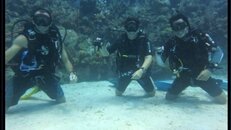well when I brought it up I got two others of the 9 to agree it was a good idea...but I got a earful of what the instructor mill "needs" and some that simply didn't agree.It does not make me feel warm and fuzzy at all. I think they have to make a stand.
But at least they have done something.
Perhaps they need to see a good example to get them going. I did the best I could as a mere PADI instructor,as i described above. Perhaps you should describe what you did when you were on the board of directors for NAUI to get them to require this kind of instruction in that organization.
I got nowhere with it I am sad to say.




